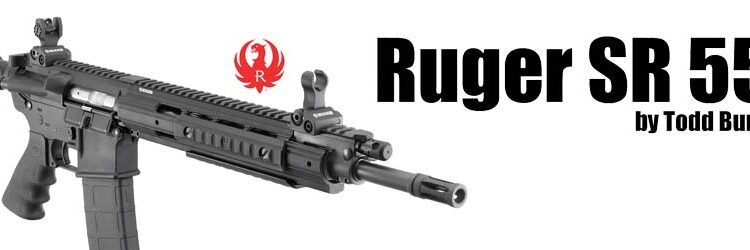By Todd Burgreen
What comes to mind if someone mentions getting a rifle for defensive purposes? Most would probably first consider the AR or AK series of weapons. Both have stereotypes that are not necessarily true. AKs are more accurate than given credit for and have better ergonomics when viewed through a fighting rifle lens. ARs are much more reliable and rugged than most give them credit for. While the AK is gaining ground in popularity in the U.S., the AR is still king in terms of numbers sold, backed-up with a cottage industry of suppliers making accessories and refinements for it. The AR is rivaling the other U.S. icon – the 1911 – in terms of available aftermarket parts and accessories, not to mention the number of different manufacturers and versions available.
ARs can be had in everything from piston-driven varieties, multiple calibers, pistol configurations, flattops, and various barrel lengths. The inherent modularity of the AR with its upper and lower receivers is its greatest attribute for adapting to individual preference; whether it is for competition, target shooting, military and law enforcement, or personal defense. This same adaptability can also lead individuals astray as to what is desired versus necessary in setting up a defensive rifle. Quad rail fore-ends festooned with lights, lasers, vertical grips, and even night vision devices are not needed in most applications and can even be detrimental to efficient use for most civilian and even law enforcement roles. A light weight, fast handling rifle is a premium when having to react to a threat. This leads us to Ruger’s entry into the AR field: the SR 556 Model 5913.
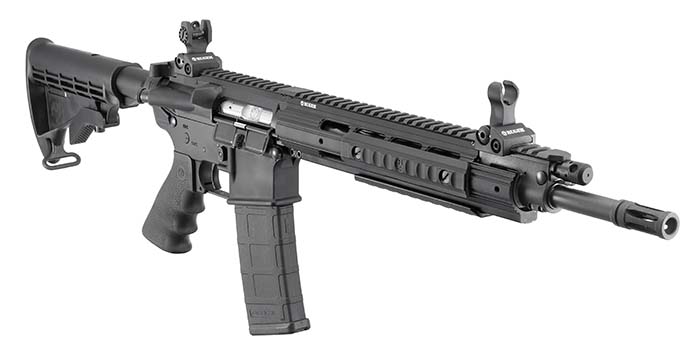
The Ruger name in the same sentence with AR is a further indication of how popular AR rifles are. The Ruger SR 556 represents the latest gas-piston AR introduced into the U.S. market. Ruger decided to enter the fray only after thoroughly exploring the topic and by designing their version of a short-stroke push rod piston driven system for the AR. One can find it indicative that the ultimate decision came down to introduce a piston-driven AR rifle versus a traditional impingement design. Ruger describes its short-stroke piston as a two-stage affair eliminating the sharp pulse often associated with other piston ARs as the op-rod strikes the flat faced carrier key located on the bolt carrier. Ruger’s transfer rod lies behind the gas block regulator and rests between captive springs and bushings. The transfer rod is acted on by the piston between it and the gas port regulator sending it rearward to work the SR 556’s action. One interesting feature of the SR 556’s operating method is the inability to remove the transfer rod and spring for routine cleaning and maintenance. Ruger claims this is not needed as the components are nickel-teflon coated for lubricity and rust resistance with the transfer rod spring made from stainless steel. The movement of the action provides a functional cleaning of the transfer rod. Another reason for Ruger wanting the transfer rod left alone are the bushings installed around it serving to further dampen vibration caused by the piston acting on the transfer rod. It could be problematic for the users to get these re-installed correctly after disassembly. The design makes the Ruger fore-end almost monolithic in design compared to free floated. Free floated fore-ends are often temperamental in finding a load that suits it compared to “bedded” fore-ends being steadier in accuracy across the board with a variety of loads.
Conversations with Ruger’s Mark Gurney helped to clarify what is meant by Ruger stating that their piston is a two-stage design. As stated above, Ruger wanted to minimize the sharp impulse of the piston striking the bolt carrier typically found in short-stroke ARs. This impulse is the cause of much criticism leveled at piston ARs associated with carrier tilt and the perception that piston driven ARs are inherently more inaccurate than their direct impingement brethren. In laymen’s terms, the Ruger piston delivers two smaller impulses to the operating rod in lieu of one longer sharper impulse of other designs. The piston fitting inside the gas regulator is acted upon initially only by a small amount of gas once cartridge ignition occurs and moves down the barrel. The smaller nipple area of the piston moves about 3/16 of an inch unlocking the action; once this happens the larger surface area of the piston is exposed allowing gas pressure controlled by regulator to effect it and cycle the action during the second stage of piston operation. The bullet has left the barrel at this stage. In summary, the first stage acts to alleviate the state of inertia in the action by a “softer” impulse which is then followed by the stronger pulse working the action. The net sum of this is less traumatic strike on the action as typified by other short stroke piston ARs leading in theory to better accuracy and better durability in the bolt carrier.
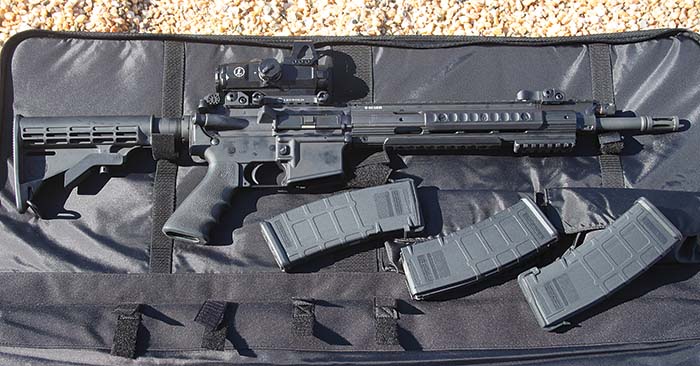
The specific Ruger SR 556 model evaluated for this article is the recently introduced SR 556 Model 5913 Carbine chambered in 5.56mm/.223 Rem. It is one of lighter Ruger AR version weighing in at slightly over 7 lbs. It features a minimized rail design and fluted barrel that helps to save weight. Not all weapons need rails and an array of accessories to be considered viable. While reliability should never be compromised in terms of cost/performance ratios, other items considered a must for some may not be high priority or worth it for others. KISS (Keep it Simple Stupid) methodology can pay dividends in terms of budget and allowing for concentration on other priorities such as training for example. The SR 556 Model 5913 Carbine shows Ruger versatility in satisfying customer needs by not using a full length quad rail, but instead a lower profile handguard with adjustable 3 inch Picatinny rail sections. The top of the rifle from back of receiver to front gas block has a full length Picatinny rail. The minimalist approach for rails still allows plenty of room for VFG and lights/lasers if so needed.
Ruger’s piston AR design has a four position gas regulator allowing for the user to completely cut gas off (setting #0) in effect making the SR 556 a manually operated rifle up to Setting #3 with the widest orifice in case the rifle is extremely fouled or underpowered ammunition encountered. Setting #2 is the normal setting. Ruger is “all in” making the SR 556 one of the most durable piston driven ARs on the market by chrome plating the piston and bolt carrier along with chrome lined Mil-Spec 41V45 1:9 twist barrel. The SR 556 Model 5913 evaluated herein has a pinned flash hider to minimize barrel length and weight. By pinning the flash hider it contributes to the overall length of the barrel for BATF regulations. Overall, length of the rifle is 31-34.24 inches depending on adjustable buttstock position.
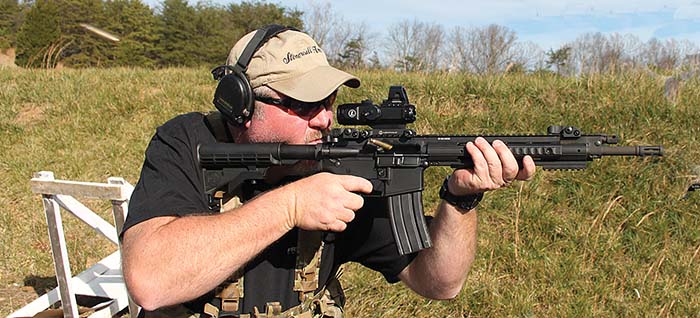
The Ruger SR 556 line up is not marketed as the least expensive AR option with MSRPs near $1,900. However, Ruger does provide a rifle that is a good value in terms of what is included with it making it ready for immediate use once unboxed. For example, three Magpul 30-round magazines are included along with a very functional soft case for the rifle. Along these lines, Troy Industries iron sights are also included serving as stand alone battle sights or folded down acting as back-up sights once an optic is mounted. A Mil-Spec trigger group rides in the Ruger’s lower receiver. An over engineered match or any kind of competition trigger that can malfunction or go out of adjustment is not suitable for a fighting rifle. All of the Ruger features are intended for maximizing effectiveness during a fight or realistic training on the range. The key component in a fighting rifle is reliability. No matter how accurate or powerful chambering a rifle is if it does not work 100% of the time it is a liability. All of these features, including slim fore-end rail, would be several hundred dollars if a user were to purchase a base rifle and set up with these features accessed as after market accessories.
It was decided to take full advantage of the Ruger’s SR 556’s flattop upper by installing several types of optics for testing. A Trijicon 3.5x ACOG TA11H model with green horseshoe reticle was mounted on the lightweight SR 556 Model 5913. Additionally, it was decided to take full advantage of the Ruger SR 556’s flattop upper by mounting the newly introduced Leupold HAMR optic. The HAMR combines a 4x main tube with a Delta Point red dot on top. It allows shooter flexibility for longer ranges as well as maintaining a CQB capability. As many “maturing” shooters can attest to the single focus plane represented by optics are easier to shoot accurately than coordinating front and rear sights. The 5.56/.223’s flat trajectory aids in making hits out to 250 yards without having to compensate excessively for bullet drop; A 200 yard zero provides for +2 inches at 100 yards and -7 inches at 300 yards. Ammunition tested with the handy SR 556 Model 5913 consisted of, but not limited to, Black Hills Ammunition loads, Hornady 60gr TAP loads, Federal Premium Law Enforcement 55gr Triple Shok and 62gr Bonded SP loads. The SR 556 kept all loads tested under 2 inches at 100 yards. Overall, the accuracy level was more than acceptable considering the barrel’s profile. Accuracy test protocol consisted of five three-shot groups with each ammunition type; group sizes were averaged.
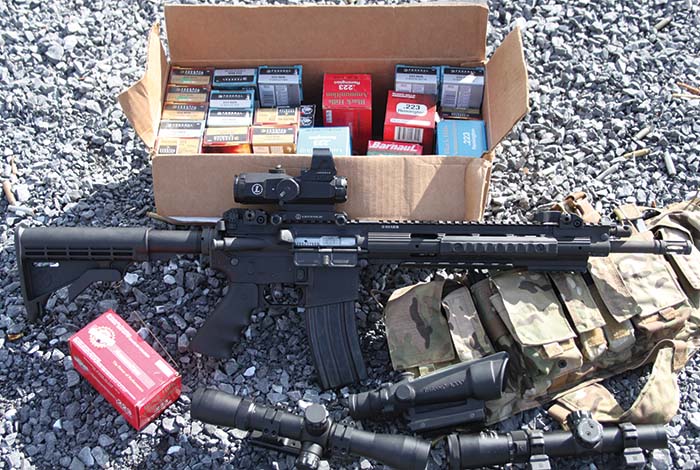
Range testing commenced with functionality testing consisting of dumping multiple magazines at several targets in rapid fashion once sight zeros were verified. Any fighting rifle must be reliable to be worthy of consideration. The Ruger AR’s gas piston operating rod system proved its worth in keeping the bolt carrier group cooler and cleaner compared to direct impingement AR rifles. Team Tactic exercises involving moving to and from a designated target area using cover while either changing magazines or engaging targets when a partner is reloading are other good weapon evaluation drills. One gets a good sense of the way a weapon handles along with reliability due to the sum of ammunition expended in short time frames characteristic of these Team Tactic drills. The collapsible stock was appreciated during these tests so that length of pull could be modified for efficiency. The Ruger SR 556 handled as expected from a lightweight AR with added confidence gained from perfect reliability. Other non-scientific tests consisted of blazing away at targets of opportunity located around the range such as car hulks, manhole covers, and TacStrike steel targets. The Trijicon ACOG performed up to its reputation with quality clear images allowing for fast targeting. The Leupold HAMR proved an asset with its dual capability sight capability. While the HAMR’s eye relief is shorter than what some may be used to on an optic, 2.7 inches, it was not found a detriment on the light recoiling AR rifle. Transitioning between the 4x main tube and Delta Point red dot sitting atop the HAMR took an orientation period to do smoothly. Both eyes open proved to be the key of finding the Delta Point dot quickly when negotiating targets at CQB ranges.
The Model 5913 SR 556 is intended for serious practitioners who plan on using it for patrolling, training, or defense. If you have ever envisioned a scenario responding to a bump or other commotion and you have to grab a bandolier of magazines and rifle on the way out of the room or from the trunk of a patrol car, then the SR 556 Model 5913 is more than worthy of consideration. Ruger’s thought process was to create a lightweight, simple to operate AR. Ruger’s counter-intuitive approach involved maximizing the AR’s effectiveness and potential by simplifying it away from current trends. AR designs consisting of heavy barrels and full-length four-sided Picatinny rails adorned with lights, lasers, vertical forward grips and other accessories were abandoned in favor of simple contemporary components of the highest quality.
The overarching theme is evident. Ruger is not advocating going retro as is evident in the piston driven design, advanced coatings on the bolt group, and flat top upper. Ruger is more than willing to utilize AR improvements as long as items contribute to the Model 5913’s effectiveness. Ruger accepts that rails are here to stay on the AR platform for a user to configure the rifle as they see fit and mount rail systems on their rifles. The fact that provision are were made to mount short sections of Picatinny rail on the handguard gives a nod to realism that high intensity flashlights serve a role and have a place with a fighting rifle. However, the need for full length quad rails adding weight and unbalancing the AR by making it front heavy is resisted. The ability to mount infrared laser designators, night vision devices, or other sorts of tactical hardware is not something most of us require in a fighting rifle. The Ruger’s 7-pound weight and minimal barrel length before being considered a NFA item gives it great balance and handling. Any doubters as to utility of a lightweight properly balanced fighting rifle should attend a rifle course from Tactical Response, Suarez International, Storm Mountain Training Center or any other reputable trainer with a rifle weighing 10 lbs or more laden with accessories and compare it to a rifle configured like the Ruger SR 556 Model 5913. It is a given which rifle allows its user to perform more dynamically, especially during cover, movement, barricade, or unorthodox firing position drills.
The Ruger decision to utilize its proven gas piston operating system derived from its SR 556 AR line-up in the slimmer Model 5913 is sound. While the Ruger SR 556 is not going to be used by our military services, law enforcement agencies could easily consider using the rifle. (Not to mention private contractors, and security conscience civilians.) With budgets constantly under pressure, the Ruger SR 556 Model 5913 could be the answer to fulfilling a multitude of roles – DMR rifle, general-purpose patrol rifle, or entry weapon. The Ruger Model 5913 could perform any of these tasks with equal aplomb. This is a positive reflection on the rifle’s accuracy, reliability, handling and ergonomics. Any law enforcement department, large or small, contemplating a piston driven AR should consider the Ruger SR 556 Model 5913.
| This article first appeared in Small Arms Review V16N4 (December 2012) |



